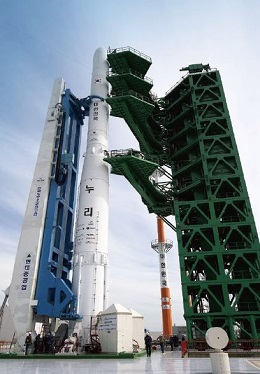On October 21st, Nuri, the first Korean launch vehicle using homegrown technology, blasted off. It was a historical day on which Korea joined the global space club. Although the rocket failed to set its 1.5-ton dummy satellite into space orbit, the self-developed rocket itself is a significant milestone for the future potential of Korean space technology. Under the initiative of Nuri, the Sungkyun Times (SKT) would like to introduce the history of the Korean space industry, the status and significance of Nuri, and the direction of development.
History of Korean Space Industry
Since the establishment of the Korea Aerospace Research Institute (KARI) in 1989, two consecutive space research schemes, the Korea Sounding Rocket (KSR) project and the Korea Space Launch Vehicle (KSLV) project, have been carried out. KARI had developed the KSR-1, KSR-2, and the KSR-3 from 1993 to 2003 as parts of the KSR project. The KSLV project, planned to devise domestic space vehicles, progressed after the KSR project. The first space vehicle developed under the KSLV was the well-known Naro, and the next rocket was the Nuri. The Naro is a double-stage rocket capable of sending a small satellite into space. It successfully launched in January 2013, sending the Naro Scientific Satellite into orbit. Although the Naro is the first space launch vehicle in Korea, its first-stage engine was imported from Russia, leaving a critical limitation by relying on foreign technology. After Naro, KARI developed Nuri, the first satellite launch vehicle made by Korea. After the test launch for the 75-ton liquid engine in 2018, the first official launch of Nuri was at 5 p.m., on October 21st in 2021. The Nuri is scheduled to launch five more times from 2022 to 2027.

The Launch Process and Significance of Nuri

Nuri is a three-stage rocket capable of directly putting a 1.5-ton satellite into sun-synchronous orbit. Sun-synchronous orbit is a space orbit where satellites can observe and take images of the earth stably. The main difference between Nuri from Naro is the engine. Naro is a double-stage rocket consisting of a first-stage liquid engine and a second-stage solid engine. However, Nuri consists of a three-stage liquid engine built with domestic technology. At the test launch in October, a 1.5-ton dummy satellite was loaded on Nuri instead of actual satellites. Nuri successfully detached the first and second stages during the launch process and separated the pairing that protects the satellite, but failed to tear off the third stage. The combustion of the three-stage engine ended 46 seconds earlier, and this resulted in its velocity only to 6.4 kilometers per second, not 7.5 kilometers that it should have been. Despite its failure, the launch of the Nuri itself has great importance. By launching Nuri, Korea became the 7th country to launch a satellite at over a ton in weight. Also, by sending satellites into space, Korea will manage its own space industry without relying on other countries. Especially at the national security level, an improvement in the possibility of launching its military satellite leads to a positive view of the intelligence capability of Korea without depending on United States (U.S.) military satellites. On October 21st, after the result of Nuri, Lim Hye-sook, Minister of Science and Information and Communications Technology (ICT), said, “We will modestly accept today’s results, make up for our improvement, and keep challenging.”
The Problems and Future Directions of Korean Space Industry Development
Insufficient Space Industry Budget
Despite the Korean space technology development, there are many structural and governmental problems to overcome yet. First, the budget for research and development in the space industry is insufficient. According to the National Assembly Research Service (NARS) report on October 19th, the Korean space development budget is only $700 million, which is too low compared to the $48 billion of the U.S., $35.8 billion of Russia, and the $8.8 billion of China. Korean budget is only 3.2% among the entire governmental research and development budget, far less than 35.6% in the U.S. and 11.5% in Russia. In addition, in Korea, most of the budget is assigned to space launch vehicle development and satellite development. It means balanced investments for other fields are also needed. Unlike in the past, when the government controlled the space industry alone, the “new space” era has arrived, in which private companies and government should cooperate.
Shortage of Space Industry Labor
Another problem is the labor shortage in the space industry. In the process of developing Nuri, there were only 250 researchers in KARI, and even if private companies were included, there were still 1,000 researchers. Compared to Russia’s Khrunichev State Research and Production Space Center, which had 30,000 employees who co-developed Naro, it is a minimal number. The shortage of private space companies is also a hardship. According to SpaceTech, a strategic analytics agency focused on space markets, major countries have hundreds of private companies related to the space industry. The U.S. is at the top with 5,582, compared to only 61 in Korea. As a result, with a shortage of labor demand and partial government investment, the outflow of human resources continues. Although Nuri failed in its final stage, it is important to focus on the potential future. With increased and continuous investment in the space industry, Korea will be able to lead the international space industry in the future.
